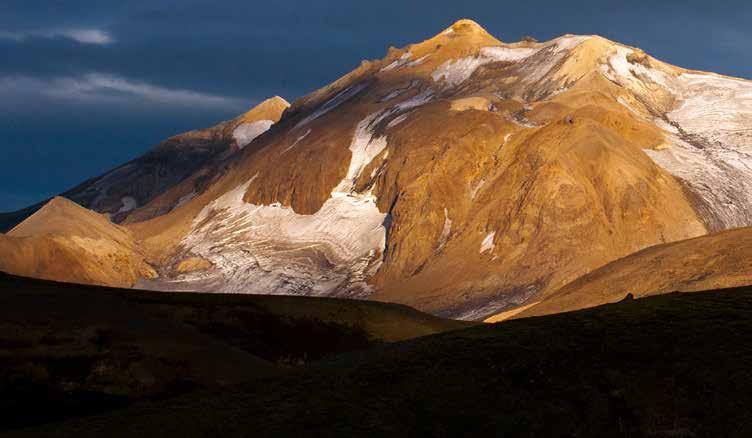
4 minute read
The Klondike of the Atlantic
COD FISHING IN THE MIDNIGHT SUN
Summer sunset over Reykjavík Harbour is now a few minutes before midnight. This fisherman was just fishing for cod in the harbour, in the soft glow of the beautiful midnight sun. Cod has been our most valuable export for centuries. The quota for cod for the current fishing year, ending on 1st September, is 217 thousand tonnes, and now that two months are left, 191 thousand tonnes have been caught, or 88% of the total catch. The average price for cod from the sea is 372 ISK / kg or 3 USD / 2.5 EUR. The average weight of cod landed in Iceland on Friday, when the picture was taken, was 3.1 kg. Jigging, or fishing with a rod and line is, of course, not part of the cod fishing quota.
THE HRINGBRAUT TRAFFIC ROUTE
This bus was on its way from Skerjafjörður to Hlemmur and from there, on to the eastern part of the city.
It’s getting darker outside. At the beginning of August, the darkness swoops in, as can be seen in the photo. Taken at half-past ten, east of Hringbraut, the twilight is well on its way to complete darkness. Hringbraut is the main road to and from the western part of the capital. On the far left of the picture, you can see six construction cranes. This is the largest construction project in Icelandic history; the new Landspítali University Hospital is being built. In the middle of the picture, at the top of Öskjuhlíð, a small hill in the city, you can see the illuminated Perlan (the Pearl) resting on six hot water tanks. There is a museum in Perlan as well as restaurants, and of course a good view of the capital area. The Pearl was opened 30 years ago, in 1991. To the left of the picture, you can see the landing lights at Reykjavík Airport. The British built the airport during World War II and it has been the centre of domestic flights in Iceland since 1945. The airport’s location has been a matter of much controversy in recent years, as many do not think it is appropriate for the city’s best building land to be used as an airport.

AUTUMN HAS ARRIVED IN HARPA
It was autumn, wind and rain at Harpa yesterday. To the left, you can see the Edition hotel, which will open soon.
The Harpa Culture and Conference Center, which opened ten years ago in May 2011, is one of Reykjavík’s prominent landmarks. The house stands on the eastern edge of the entrance to Reykjavík Harbour. Due to fewer restrictions on the number of people allowed to gather, many concerts and events are on the agenda. Harpa has more or less been closed for a year and a half due to the pandemic. South of Harpa, two large and impressive houses are being built, the headquarters of Landsbanki Íslands, and Edition Hotel, the first five-star hotel in Iceland. These buildings will change the appearance of the capital considerably when they are completed.



THE FRENCH STREET IN REYKJAVÍK
Frakkastígur (French Street) is one of the most beautiful streets in the city centre. It is situated north of Skólavörðustígur and travels down from Hallgrímskirkja to the sea. At either end of the street are works of art. The statue of Leifur Eiríksson stands at the top of Skólavörðuholt, and The Sun Voyager by Jón Gunnar Árnason stands by the shore on Sæbraut. Jón Gunnar won a competition for outdoor works for the 200th anniversary of the City of Reykjavík in 1986. The artwork was unveiled in 1990. Frakkastígur takes its name from the French wooden houses that were transported from Austurstræti in 1901 when the street was built. At the bottom of Frakkarstígur, French shipping companies built a hospital in 1902, which is now used by a music school. Between 1830 and 1914, the French fished cod in Icelandic waters. It is estimated that around 4,000 French fishermen lost their lives by Iceland during this period.
The Culture House on the left was designed by the Danish architect Johannes M Nielsen. The National Theatre on the right was designed by Guðjón Samúelsson, the State Master Builder.
THE TWO CULTURE HOUSES ON HVERFISGATA
The Culture House on Hverfisgata was built between 1906 and 1909 to house the National Library of Iceland, the National Archives of Iceland and the National Museum of Iceland. The National Gallery of Iceland now operates the building, as the museums originally in the Culture House have received new and more suitable premises. The current exhibition in the house is “Fjársjóður Þjóðar” (“The Nation’s Treasures”), pearls of Icelandic art from the second half of the 19th century to the present day. The National Theatre was opened in 1950, after being under construction since 1925, or for a quarter of a century. More than five million people have enjoyed performances in the National Theatre in the 70+ years since it opened. The house was designed by Guðjón Samúelsson almost a hundred years ago.










